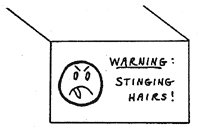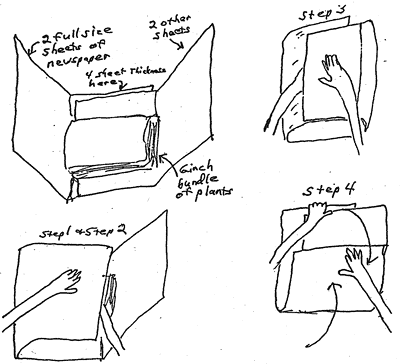 |
Search Catalog
Site Navigation:
Home
Projects &
Online Books
Reference Services
Other Services
Archives
Collections
Botanicus Digital
Library
Library Links
Staff
Research Home

Contribute to
the Ellerman
Challenge
Field Techniques Used by Missouri Botanical GardenDRYING AND SORTING When building a press, always keep the numbered side of the sheets up. It saves time in the long run. Mark the press so you know which side is the top without opening it (always placing the straps on the same way is one method). Do not turn around every other sheet to balance the press. It wastes time. Do 20 to 40 sheets and then reverse the direction of the newspaper folds as necessary. Try to make the change at the end of a collection number. It helps as you are pressing to put large fruits, stems, etc., on different parts of the sheet to balance them. When breaking down a press, keep separate any sheets not fully dried with their corrugates, etc., as a unit. Do not scatter them in among another press that is being built. Two sequences interspersed are more time consuming to sort numerically later.  Experience has shown Example No. 1 is the best way of combining sheets. Have the open edge of the newspaper on the same side. It is best for the specimens and the easiest to handle. The logic of Example No. 2 is that if pieces fall out they will still be in the outside sheet. But this package does not have as much structural stability. When it is handled and carried, more damage is done in the long run. Try picking up the same specimens as arranged in examples one and two with the one hand and you will understand. In Example No. 1, the sheets press together slightly, holding the material firmly and protecting it. You can also open both sheets with one motion and see the plant and label. With Example No. 2, you first have to move the top sheet and then you have to move the second sheet to see the plant and label. This takes more time and the extra handling also results in more damage. To look at the specimen and labels of Example No. 3, you have to open several sheets. You cannot do it with one motion because you do not know how many sheets to lift at one time. Example No. 3 is very difficult to process and to study. A few collectors put extra sheets around each individual sheet. It does more harm than good. It has less structural stability than the first method. Also, the specimens have to be handled more to open and look at them. But it does pay to put extra newspaper sheets around a few extra big specimens. It is always useful to make packets out of newspaper to hold loose fruit or flowers which would otherwise easily fall out and be lost. As you are breaking down the press, hold the open side of the newspaper higher. Then loose pieces will tend to slide to the safer folded edge. If there are many loose flowers or fruits, tap the edge slightly to move the parts closer to the folded edge. As you are breaking down the press, open the first sheet of each collection and put the remaining sheets in as you are doing it. Much more time is saved later than is lost doing it. Each sheet is most easily moved in the direction of the fold. That way the newspaper will not flop open because of movement through the air. Once the plants are all dry, put them into numerical order. Then all specimens of a collection will be together. It will save time and confusion. This is also a good step for catching mixed collections, rechecking the number of labels needed if necessary, and other miscellaneous problems. If there are specimens without numbers, write "specimen in bundle between number XX and number XX." This is especially important when sorting someone else's plants if you cannot solve all of the problems. Otherwise, the collector may not be able to solve the problem later, either. After they are in numerical order, pull out the set that is to stay in the country of origin. In some cases all specimens are shipped out of the country first, then after processing a return-to-country-of-origin set (RTCO) is returned by mail later. Almost always, it is better to leave the set in the country, avoiding all the costs and problems of shipping, customs, accidents, etc. Be certain to keep both sets in numerical order as you are doing this. Always note in your field book if you have left a set or will mail a set, and if extra labels are needed for the set left in the country of origin. Mark each collection minus the institution that has received a specimen (i.e., -CR, if a set was left there). At later steps always mark the remaining sheets minus the sheet that was pulled out (i.e., -MO if MO's sheet was mounted, -US if a sheet was sent to a specialist at US), this prevents duplicates from being sent on exchange to institutions that already have a sheet. Send all of the specimens and separate fruits of a collection in the same shipment. Once a collection is identified, one specimen is mounted, and the balance are sent on exchange. If additional sheets or separate fruits from the same collection are received later, it is impossible to know where the collection was previously sent. It helps in sorting if "Separate Fruit or parts" is marked on the newspaper. If there is a possibility that the plants will be fumigated later with a microwave oven, do not use staples, paper clips, or other metal objects. Mark specimens with irritating hairs or resins, such as Mucuna (Fabaceae), Opuntia (Cactaceae), Sterculia (Sterculiaceae), Urtica (Urticaceae), and Toxicodendron (Anacardiaceae), with warnings on drop tags or on the outside of the bundle and the edge of the newspaper:  To wrap bundles of plants use four pieces of full-sized paper. Overlap half of two sheets. Place a bundle of plants at least six inches thick onto the paper and fold the edges of the paper firmly around the specimens and tape closed or tie with string. Do not use valuable corrugates or old genus coversto ship plants. Label each bundle with the name of the collector and the number range contained in the bundle. Many overlapping number ranges without an indication of the collector can cause confusion if bundles arrive from two or more collectors at the same time. One method of wrapping:  When shipping plants in newspaper, pack bundles of wrapped plants tightly in boxes rather than loosely. Even though a slight amount of damage may be incurred when packing the boxes tightly, plants in loosely packed boxes are much more easily damaged during shipping and the boxes more prone to being crushed. Reheating the paper wrapped bundles over dryers, packing them in tightly sealed boxes or plastic bags (with PDB or Napthalene if available) reduces insect damage during storage or during the long trip back to the home institution. Always pack specimens to withstand the possibility of moisture or pest damage. Surface mail from some countries may be 3 to 12 months. With the shipment send details of any special arrangements made with the host country and or other collectors (such as where duplicates are located or where they are promised to be distributed). Project coordinators need to know these arrangements before they process the plants, not after they are distributed and not available to satisfy agreements made by the collector. MO sometimes stamps special agreements on the edge of the newspaper of each collection. With the shipment, also include some kind of shipping invoice so that the receiving institution knows what is in the boxes and why they are being sent. These invoices should include the sender's name and address, receiver's name and address, list of enclosed items, number of boxes (copies of the invoice should be in each box), and any special instructions or conditions. It is also helpful to know how the plants have been chemically treated (i.e., formaldehyde, alcohol, insecticides, etc.).
|
© 1995-2025 Missouri Botanical Garden, All Rights Reserved
P.O. Box 299, St. Louis, MO 63166-0299
314-577-5100
See the World!
Technical Support

